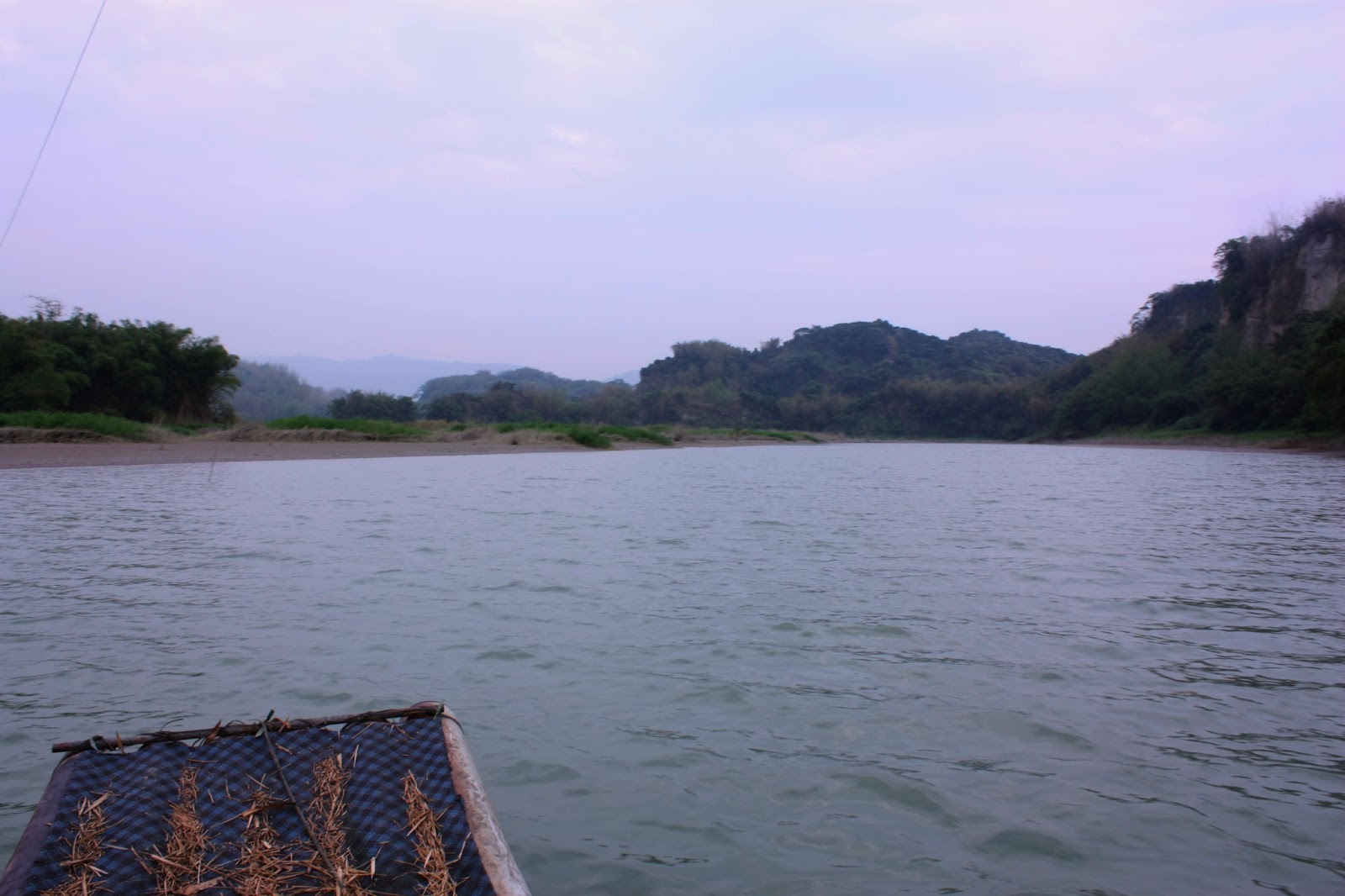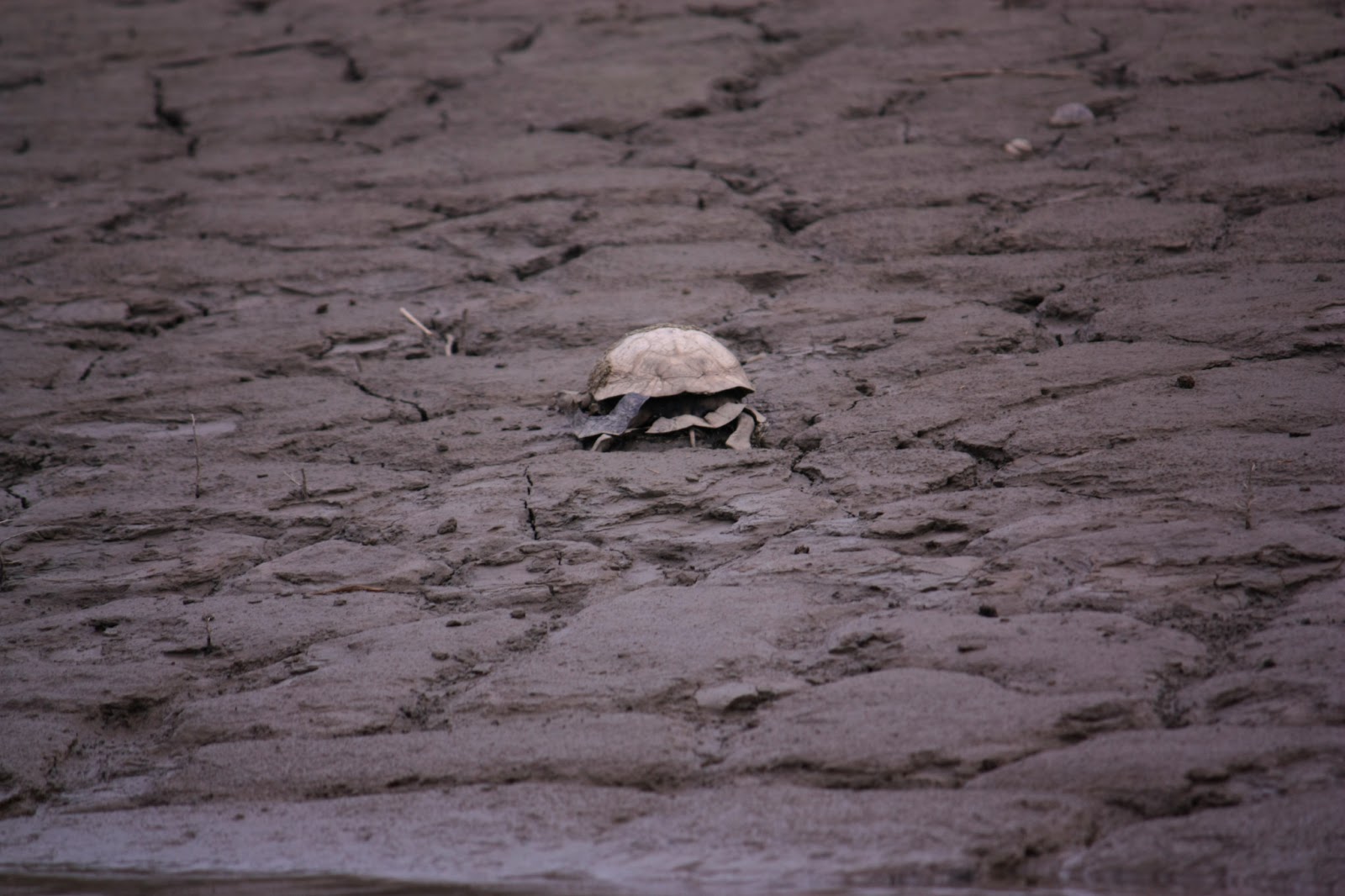Recent weather forecasts for rain have all proven to be wrong; although I was dissuaded from going out to Wushantou reservoir again early on Friday and Sunday mornings last week due to heavy rain, that rain didn't last more than an hour or two. So on Sunday afternoon, I headed back out again even though it was a dull, overcast day not ideal for taking pictures. The shot below shows one entrance to the southern harbour, where a number of variously sized and variously equipped rafts are tied up. I have always borrowed the same one and tied it up again when I'm finished in the same place; the boss had liked my eagle pictures last time, and I might see about framing one or two of the better ones...
My main purpose on Sunday afternoon was to follow the main course of the Guantian river as it enters Wushantou reservoir and not - as I had mistakenly done on a previous occassion - follow a mere secondary channel resulting from erosion. I wanted to follow it for some indeterminate distance simply in order to photograph the landscape contours and also just because I like doing this kind of thing (it's not for everyone; for one thing, paddling a raft for hours on end over several miles demands a bit of physical strength - if I sat in front of a keyboard all day, living on a diet of instant noodles, I just wouldn't be able to do it). Aside from that however, I was also curious to see whether the water level had dropped further due to the lack of rainfall. It had, although this was more apparent in some places than others - the bed of the reservoir is not even and there are several natural bottlenecks that limit the passage of water from the river into the interior of the reservoir when the water level drops below a certain point. Since my previous visit to this part of the reservoir about two weeks ago, the water level had dropped by at least a meter, if not more. It was so bad that, after the bottleneck I found myself in water only a few inches deep with islands of mud off to the east...
At that point I simply got off the raft and walked, dragging it behind me with the tow-rope until I rounded the corner to the river channel at which point I correctly anticipated that the water depth would very suddenly drop. I climbed back onto the raft just before I reached that point, and was able to stick the entire length of my two meter paddle in once again without it touching the bottom.
At this point, the river's final stretch as it enters the reservoir, there were a noticeable number of birds in the air - mostly swallows or martins, sparrows and other passerines, but with a few eagles, one osprey, a couple of kites and one falcon of some kind (though due to light and distance, I wasn't able to get a decent shot; I identified it as a falcon only on the basis of shape). Here it is with a swallow to the left - although the bird is too distant, the "thin" shape of the tail is fairly clear - and that, along with size, is indicative of a falcon rather than a hawk or eagle...
So that in itself is an interesting discovery. Apparently there are only four species of falcon in Taiwan, the Kestrel, the Merlin, the Hobby and the Peregrine Falcon. In all the time I was observing it (maybe 10-15 minutes as I paddled) I never saw it pull the distinctive hover moevement typical of Kestrels and Merlins, but that may have been because it was getting mobbed to some extent by the swallows so it's difficult to tell. I might get some better shots in the future if I play my cards right. Here is a shot of one of the kites with a swallow alongside him for scale (bear in mind that the kites are only about half to two-thirds the size of the eagles)...
The presence of so many birds near to the river's entrance to the reservoir (and their comparative absence elsewhere) indicates food - insects for the passerines, and fish, rats and lizards for the birds of prey. It may be that the river channel is where the water is deepest (well over two meters, even at this low level) and therefore where food is in more plentiful supply. Here I am approaching the first of three bends in the river channel as it enters the reservoir...
And on the way around that bend...
And looking back the way I had came...
And looking upstream after the bend had been rounded...
Just before I arrived at the next bend I found that that here were other people on the river besides myself. Notice the chap at the front with his camera out taking a picture of the "wild foreigner"...
... which he has every right to do since I suppose I must have been a bit of an unusual sight. For one thing, I was paddling rather than using an engine, and for another thing the fact that I had taken my shirt off earlier meant that my skin colour and chest hair made me out as an obvious westerner and not a local fisherman. The guy who was in control of their boat was a local fisherman and he asked me if I wanted him to tow me back the way I had came, to which the answer was never going to be "yes" was it? It's the kind of question that gets asked out of politeness' sake due to his company - normally the local fishermen would never ask me that, they would just wave a "ni hao" to me. I said I'd be alright and get back by myself in a short while. After I rounded that second bend, I looked downstream and toyed with the alternatives of going ahead and heading back...
I kept going just to see how narrow the river would become at the next bend surrounded by reeds in the distance - I suspected that it might narrow (I was wrong). Here is a shot of the broken cliff just before the next bend with one of the larger sized rafts moored up against it..
The technology for judging changes to the water level is very simple...
I suspect that this particular bamboo pole is actually used by the fishermen to judge when they have strayed from the natural channel of the river when the water level rises above the reeds; you wouldn't want your propellor to get caught up in them by accident. Other poles like this one are probably there to indicate areas of shallow water; for someone like me using a paddle and a narrow raft with no serious baggage, the shallows are not a problem, but if I were using one of the larger rafts equipped with an engine and a bag full of fish or fruit, then it would be useful to know when to disengage and lift up the propellor.
There were some noisy, black and red birds among the reeds similar in size and shape to a large thrush or a small magpie. I'm not an expert but the first bird I can find that seems to be a rough fit (size and colour) is the "Maroon Oriole", though whether it was this bird or another I don't know.
Around that third bend, there were two small jetties on either bank with more rafts moored for the local fishermen and the river stretched out into the distance to draw yet another 'S' curve on the way up into Nanxi district where it is fed by a diversion from the Tseng-wen river engineered by the Japanese some eighty-odd years ago...
Having reached this point, and with the time already drawing up to 5pm, I decided it was time to turn around as I wanted to be back at the southern harbour before 7pm. Here is the view back westward toward the broken cliff once I turned the raft around...
Despite pausing for a few more photographs of birds and whatnot I actually managed to get back just after 6pm, which is a pretty good time for what must be somewhere between two and three kilometers. On the way back I stopped to photograph something which I had seen on the westward bank of the river earlier but had dismissed as a stone...
It was a dead tortoise, covered in maggots as it lay rotting on the parched clay. When I was close enough to decide it wasn't a stone, the only question was whether it was a tortoise (non-aquatic) or a fresh-water turtle (semi-aquatic)...
... although you can see the foot and toes at the end of the frong-right leg, it has rotted so much that I can't be sure whether there had previously been webbing there or not. As for size, I should have put my own foot next to it - memory is unreliable, but I'd guess eight to ten inches long. Not knowing much about tortoises and turtles, I can't guess what species it was. If it was a tortoise, then the question is how did it get there if not by drowning after being thrown away by somebody on a raft... and if it was a fresh-water turtle, then the question is how did it end up dying on an exposed river bank only a couple of feet from the water's edge and facing the wrong way?



















No comments:
Post a Comment
Comment moderation is now in place, as of April 2012. Rules:
1) Be aware that your right to say what you want is circumscribed by my right of ownership here.
2) Make your comments relevant to the post to which they are attached.
3) Be careful what you presume: always be prepared to evince your point with logic and/or facts.
4) Do not transgress Blogger's rules regarding content, i.e. do not express hatred for other people on account of their ethnicity, age, gender, sexual orientation or nationality.
5) Remember that only the best are prepared to concede, and only the worst are prepared to smear.